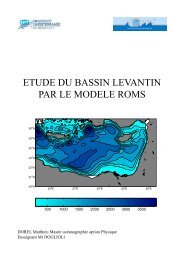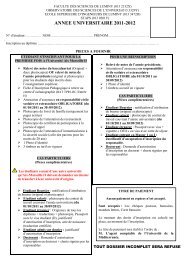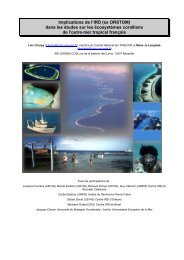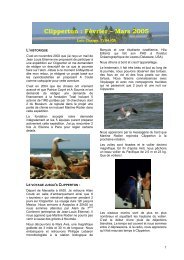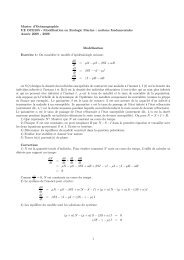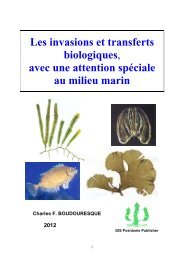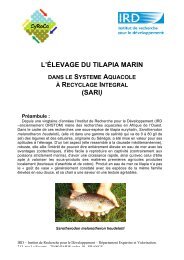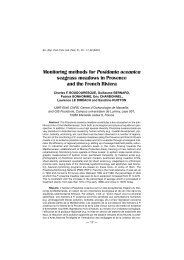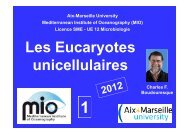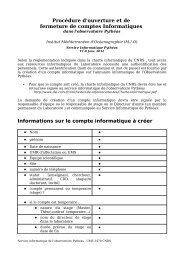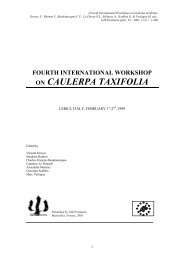Pour en savoir plus - Centre d'Océanologie de Marseille
Pour en savoir plus - Centre d'Océanologie de Marseille
Pour en savoir plus - Centre d'Océanologie de Marseille
You also want an ePaper? Increase the reach of your titles
YUMPU automatically turns print PDFs into web optimized ePapers that Google loves.
Figure 26 : Abondance <strong>de</strong> Merismopedia glauca aux trois stations et aux <strong>de</strong>ux niveaux au cours du<br />
cycle annuel........................................................................................................................................61<br />
Figure 27 : Abondance <strong>de</strong> Microcystis aeruginosa aux trois stations et aux <strong>de</strong>ux niveaux au cours<br />
du cycle annuel ..................................................................................................................................61<br />
Figure 28 : Abondance <strong>de</strong> Rhabdo<strong>de</strong>rma lineare aux trois stations et aux <strong>de</strong>ux niveaux au cours du<br />
cycle annuel........................................................................................................................................61<br />
Figure 29 : Abondance <strong>de</strong> Monoraphidium circinalis aux trois stations et aux <strong>de</strong>ux niveaux au<br />
cours du cycle annuel.........................................................................................................................63<br />
Figure 30 : Abondance <strong>de</strong> Oocystis lacustrus aux trois stations et aux <strong>de</strong>ux niveaux au cours du<br />
cycle annuel........................................................................................................................................63<br />
Figure 31 : Abondance <strong>de</strong> Sc<strong>en</strong>e<strong>de</strong>smus magnus aux trois stations et aux <strong>de</strong>ux niveaux au cours du<br />
cycle annuel........................................................................................................................................63<br />
Figure 32 : Abondance <strong>de</strong> Tetraedron caudatum aux trois stations et aux <strong>de</strong>ux niveaux au cours du<br />
cycle annuel........................................................................................................................................65<br />
Figure 33 : Abondance <strong>de</strong> Tetraedron muticum aux trois stations et aux <strong>de</strong>ux niveaux au cours du<br />
cycle annuel........................................................................................................................................65<br />
Figure 34 : Variation du biovolume total <strong>de</strong> Cylindrospermopsis raciborskii aux trois stations et<br />
aux <strong>de</strong>ux profon<strong>de</strong>urs (surface et fond) au cours du cycle annuel ....................................................65<br />
Figure 35 : Variation du biovolume <strong>de</strong> Lyngbya versicolor aux trois stations et aux <strong>de</strong>ux<br />
profon<strong>de</strong>urs (surface et fond) au cours du cycle annuel ....................................................................67<br />
Figure 36 : Variation du biovolume <strong>de</strong> Chroococcus globosus aux trois stations et aux <strong>de</strong>ux<br />
profon<strong>de</strong>urs (surface et fond) au cours du cycle annuel ....................................................................67<br />
Figure 37 : Variation du biovolume moy<strong>en</strong> <strong>de</strong> 4 espèces <strong>de</strong> cyanobactéries au cours du cycle annuel<br />
............................................................................................................................................................67<br />
Figure 38 : Variation du biovolume <strong>de</strong> Fragilaria sp. aux trois stations et aux <strong>de</strong>ux profon<strong>de</strong>urs<br />
(surface et fond) au cours du cycle annuel.........................................................................................69<br />
Figure 39 : Variation du biovolume <strong>de</strong> Gyrosigma wormleyi aux trois stations et aux <strong>de</strong>ux<br />
profon<strong>de</strong>urs (surface et fond) au cours du cycle annuel ....................................................................69<br />
Figure 40 : Variation du biovolume <strong>de</strong> Pediastrum clatrathum aux trois stations et aux <strong>de</strong>ux<br />
profon<strong>de</strong>urs (surface et fond) au cours du cycle annuel ....................................................................69<br />
Figure 41 : Variation du biovolume <strong>de</strong> Pediastrum duplexe var. typicum aux trois stations et aux<br />
<strong>de</strong>ux profon<strong>de</strong>urs (surface et fond) au cours du cycle annuel. ..........................................................71<br />
Figure 42 : Variation du biovolume <strong>de</strong> Eugl<strong>en</strong>a anaba<strong>en</strong>a aux trois stations et aux <strong>de</strong>ux<br />
profon<strong>de</strong>urs (surface et fond) au cours du cycle annuel ....................................................................71<br />
Figure 43 : Evolution du compartim<strong>en</strong>t du phytoplancton au cours du cycle à partir <strong>de</strong>s paramètres<br />
<strong>de</strong>scriptifs (moy<strong>en</strong>nes). ......................................................................................................................71<br />
Figure 44 : Variation <strong>de</strong> l’abondance du phytoplancton total le long du transect sud-nord (voir<br />
carte). .................................................................................................................................................73<br />
Figure 45 : Composition du phytoplancton le long <strong>de</strong> la radiale sud-nord. ......................................73<br />
Figure 46 : Evolution <strong>de</strong> l’abondance <strong>de</strong>s trois espèces dominantes <strong>de</strong> phytoplancton le long <strong>de</strong> la<br />
radiale sud- nord. ...............................................................................................................................73<br />
Figure 47 : Evolution du pourc<strong>en</strong>tage d’effectif <strong>de</strong>s différ<strong>en</strong>ts groupes fonctionnels dans la<br />
communauté phytoplanctonique........................................................................................................77<br />
Figure 48 : Variation <strong>de</strong> l’abondance du zooplancton total aux trois stations..................................77<br />
Figure 49 : Evolution comparée <strong>de</strong> la moy<strong>en</strong>ne <strong>de</strong> l’abondance du zooplancton et <strong>de</strong>s trois espèces<br />
dominantes <strong>de</strong> phytoplancton au cours du cycle annuel à la station Baie. .......................................81<br />
Figure 50 : Evolution <strong>de</strong> la vitesse et <strong>de</strong> la direction du v<strong>en</strong>t (composante Nord et composante Est)<br />
et <strong>de</strong> l’int<strong>en</strong>sité <strong>de</strong> la lumière (irradiance totale). ..............................................................................81<br />
Figure 51 : Variation du rapport N/P (moy<strong>en</strong>ne <strong>de</strong>s trois stations stations) par rapport à celui <strong>de</strong><br />
Redfield...............................................................................................................................................81



